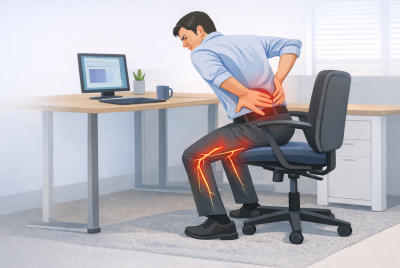Pregnancy and Sciatica
Discover effective strategies to manage pregnancy and sciatica with expert tips and advice. Find relief and enjoy your journey to motherhood! Many women experience a range of discomforts during pregnancy, and one of the most common is sciatica. Sciatica refers to pain that radiates along the path of the sciatic nerve, which branches from your lower back through your hips and buttocks and down each leg. As someone passionate about sciatica health and eager to provide helpful suggestions, I understand the challenges that come with this condition during pregnancy. In this article, I’ll discuss the causes, symptoms, and effective management strategies for sciatica during pregnancy.
Causes of Sciatica During Pregnancy
Pregnancy brings about significant changes in a woman’s body, some of which can contribute to the development of sciatica.
Increased Weight and Pressure on the Spine: As the baby grows, the extra weight puts added pressure on the spine and sciatic nerve.
Hormonal Changes: Hormones released during pregnancy can loosen ligaments and muscles, leading to increased vulnerability to nerve compression.
Postural Changes: The growing uterus alters the woman’s posture, which can strain the lower back and exacerbate sciatic nerve pain.
Pregnancy-Safe Sciatica Pain Relief Stretches
Symptoms of Sciatica During Pregnancy
Identifying the symptoms of sciatica can help pregnant women seek appropriate treatment and management strategies.
Radiating Pain in the Lower Back and Legs: Sharp, shooting pain that travels from the lower back through the buttocks and down the legs.
Numbness or Tingling Sensation: Sensations of pins and needles or numbness in the affected leg or foot.
Weakness in Legs: Difficulty in moving the legs or experiencing weakness in the affected leg muscles.
Risk Factors for Pregnant Women
While sciatica can occur in any pregnant woman, certain factors may increase the likelihood of developing this condition.
Age of the Mother: Older pregnant women may be at a higher risk due to pre-existing spine issues or reduced flexibility.
Previous History of Sciatica: Women who have experienced sciatica before pregnancy are more susceptible to recurrence.
Multiple Pregnancies: Carrying multiple babies simultaneously can increase pressure on the spine and exacerbate sciatic nerve pain.
Tips for Managing Sciatica During Pregnancy
Effective management of sciatica during pregnancy involves a combination of lifestyle adjustments and therapeutic interventions.
Proper Posture: Maintaining good posture while sitting, standing, and sleeping can alleviate pressure on the sciatic nerve.
Exercise and Stretching: Engaging in gentle exercises and stretches recommended by healthcare providers can strengthen muscles and improve flexibility.
Heat and Cold Therapy: Applying heat packs or cold compresses to the affected area can help reduce inflammation and alleviate pain.
Prenatal Massage: Regular prenatal massages from a certified therapist can provide relief from sciatic nerve pain and promote relaxation.
Pelvic Floor Strengthening Exercises: Strengthening the pelvic floor muscles can support the lower back and reduce pressure on the sciatic nerve.
When to Seek Medical Help
While mild sciatic nerve pain is common during pregnancy, certain symptoms warrant immediate medical attention.
Persistent or Severe Pain: Pain that persists despite conservative measures or becomes increasingly severe.
Loss of Bladder or Bowel Control: Difficulty in controlling bladder or bowel movements, which may indicate nerve compression.
Numbness Around the Genital Area: Numbness or loss of sensation in the genital area may signal a serious underlying issue.
Treatment Options
In cases where conservative measures fail to provide relief, healthcare providers may recommend the following treatment options.
Physical Therapy: Targeted exercises and manual therapy techniques can help alleviate sciatic nerve pain and improve mobility.
Chiropractic Care: Spinal adjustments performed by a qualified chiropractor can realign the spine and alleviate nerve compression.
Acupuncture: Acupuncture sessions may provide relief from sciatic nerve pain by stimulating specific pressure points in the body.
Medications: In some cases, healthcare providers may prescribe pain medications or muscle relaxants deemed safe for pregnant women.
Precautions and Considerations
Pregnant women with sciatica should take certain precautions to prevent worsening of symptoms.
Avoiding Heavy Lifting: Refraining from lifting heavy objects to prevent strain on the lower back and sciatic nerve.
Using Proper Body Mechanics: Practicing proper body mechanics when performing daily activities to minimize stress on the spine.
Consulting Healthcare Provider: Always consult a healthcare provider before taking any medications or undergoing treatment for sciatica during pregnancy.
FAQs Related to Pregnancy and Sciatica
Can sciatica harm my baby during pregnancy?
No, sciatica itself does not directly harm the baby during pregnancy. However, it can cause discomfort for the mother, impacting her ability to move comfortably. It’s essential to seek appropriate management strategies and consult healthcare providers to ensure the well-being of both mother and baby.
Will sciatica go away after I give birth?
Sciatica often resolves on its own after childbirth as the body gradually returns to its pre-pregnancy state. However, the timeline for resolution varies for each individual. Seeking appropriate management strategies and postpartum care can help alleviate symptoms and promote recovery.
Can I still exercise with sciatica during pregnancy?
Yes, gentle exercises and stretches recommended by healthcare providers are generally safe and beneficial for managing sciatica during pregnancy. It’s essential to consult with a healthcare provider to determine the most appropriate exercises based on individual circumstances and to avoid exacerbating symptoms.
Is it safe to take pain medication for sciatica while pregnant?
It’s crucial to consult a healthcare provider before taking any pain medication for sciatica during pregnancy. While some medications may be deemed safe, others could pose risks to the developing baby. Healthcare professionals can provide personalized guidance and recommend the safest options based on individual circumstances.
How long does it take for sciatica to resolve after childbirth?
The resolution of sciatica after childbirth varies for each individual. While some may experience relief within weeks, others may take months to recover fully. Seeking appropriate management strategies and postpartum care can help facilitate recovery and alleviate symptoms over time.
Extra FAQs Related to Pregnancy and Sciatica
How can I relieve sciatic nerve pain during pregnancy?
To relieve sciatic nerve pain during pregnancy, consider maintaining proper posture, engaging in gentle exercises and stretches recommended by healthcare providers, applying heat or cold therapy to the affected area, receiving prenatal massages, and strengthening pelvic floor muscles. Consult healthcare providers for personalized guidance and treatment options.
When does sciatica start during pregnancy?
Sciatica can occur at any stage of pregnancy, but it often starts in the second or third trimester. As the baby grows, increased pressure on the sciatic nerve, hormonal changes, and postural adjustments contribute to the onset of sciatic nerve pain. Early intervention and management strategies are crucial for relief.
How long does a sciatica flare-up last in pregnancy?
The duration of sciatica flare-ups during pregnancy varies for each individual. Flare-ups may last for a few hours to several days, depending on factors such as the severity of symptoms, management strategies, and individual response to treatment. Consistent management and seeking medical advice can help alleviate flare-ups effectively.
Is walking good for sciatica?
Yes, walking can be beneficial for relieving sciatica symptoms during pregnancy. It helps to improve circulation, maintain flexibility, and strengthen muscles, which can alleviate pressure on the sciatic nerve. However, it’s essential to walk at a comfortable pace and avoid activities that exacerbate pain.
What not to do with sciatica?
When you have sciatica during pregnancy, it’s important not to engage in activities that worsen symptoms, such as heavy lifting or prolonged sitting or standing. Avoiding high-impact exercises, poor posture, and improper lifting techniques can prevent exacerbation of sciatic nerve pain. Consult healthcare providers for personalized advice and guidance.
Pregnancy and Sciatica – Conclusion
In conclusion, navigating sciatica during pregnancy can be daunting, but with proper management and support, relief is achievable. By maintaining good posture, engaging in gentle exercises, and seeking medical guidance when necessary, expectant mothers can alleviate discomfort and focus on the journey to motherhood. While sciatica may persist after childbirth for some, many find relief as their bodies gradually return to normalcy. Remember, each pregnancy journey is unique, so it’s crucial to listen to your body and seek personalized care. With perseverance and patience, sciatica can be effectively managed, allowing mothers to cherish every moment of pregnancy.
By following these tips and seeking appropriate medical guidance, pregnant women can effectively manage sciatica and focus on the joys of impending motherhood.
Disclaimer
Please note that the information provided in this article is for informational purposes only and should not replace professional medical advice. If you’re experiencing sciatica pain or any health concerns, it’s advisable to consult a healthcare professional for proper diagnosis and treatment.






